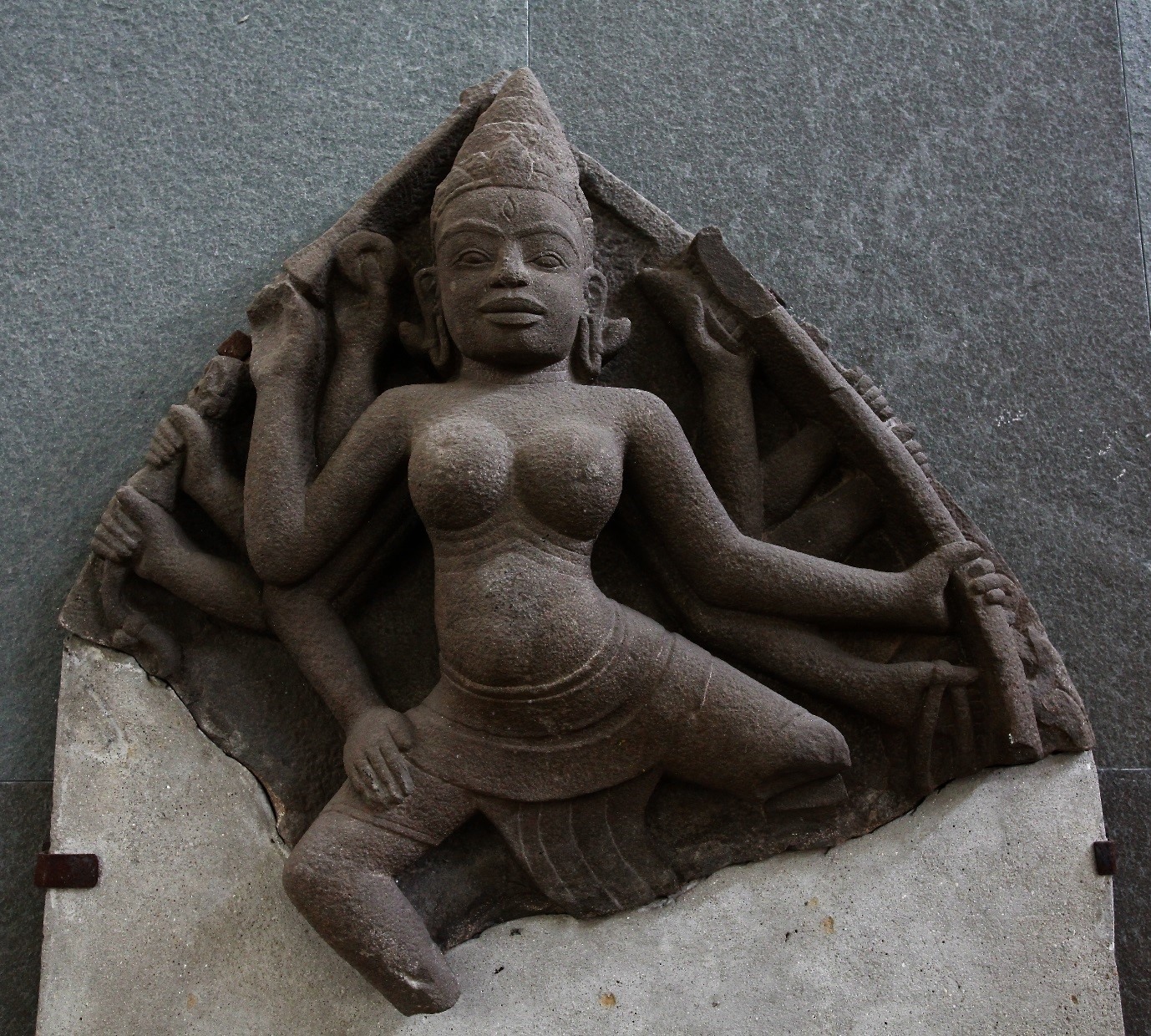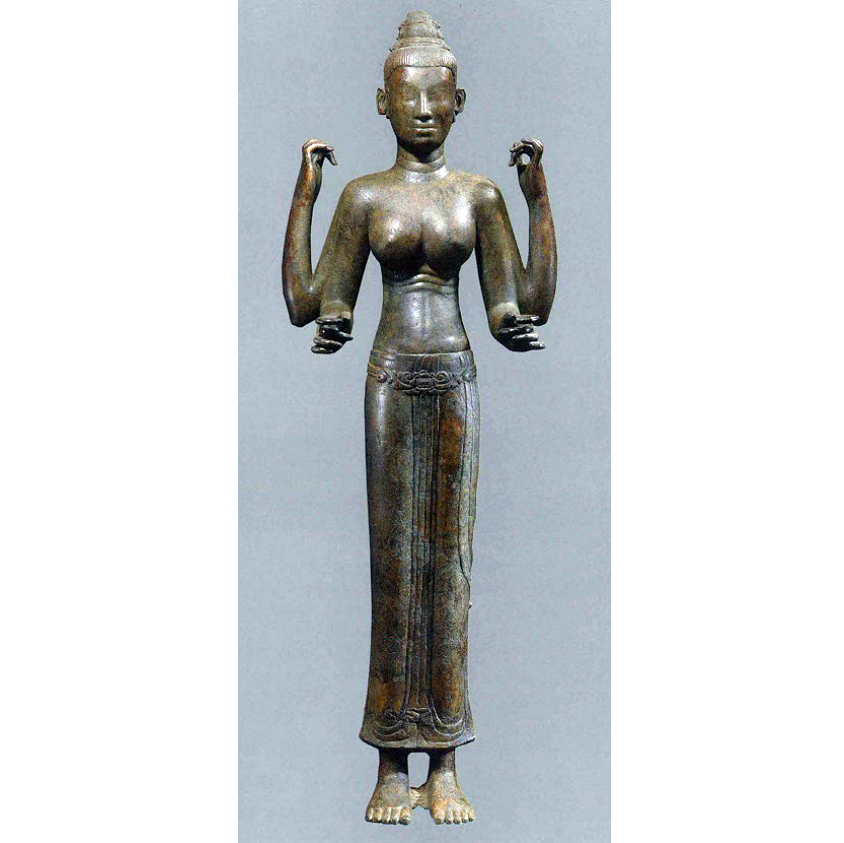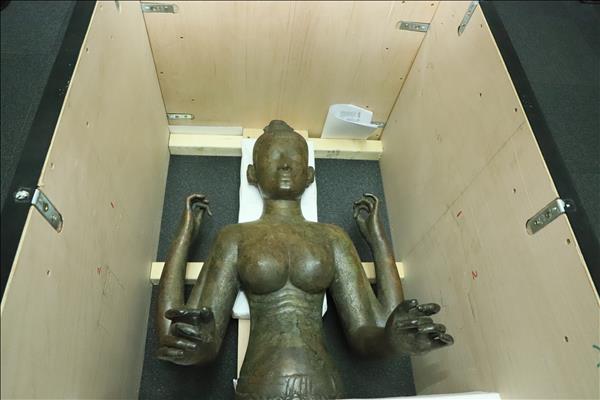Through research documents with similarities, it is possible to hypothesize: Is it possible that the Durgā bronze statue (E4?) and the Śiva sandstone statue (C1), with similar sizes and styles, are a pair of objects? present the idea of the supreme deity Śiva accompanied by Śakti, as honored with the name Maheśvara Umā in the opening line of the oldest inscription at the My Son Ruins?

Legend of Durgā
Hindu scriptures and myths have long explained the power of the gods as the harmonious combination of male and female; Within a male deity there must be a “divine feminine”, which constitutes the divine energy (Sanskrit: Śakti).
This idea is conveyed in mythology through stories about “wives,” who are the embodiment of the god’s Śakti. The “wife” of god Śiva has different names such as Umā, Parvatī, Durgā…, associated with many mysterious stories, interwoven with details and characters.
A story about the birth of goddess Durgā explains the great power of this deity. In ancient times, there was the demon Mahiśāsura, evil in nature, but wishing to become immortal. Mahiśāsura was originally a devotee of Brahma, showed loyalty and asked Brahma for a favor that he would never be killed by any man.
When he had that privilege, Mahiśāsura turned back to attack the heaven of the gods and all the gods and goddesses could not destroy it. To deal with that unfortunate situation, the gods Brahma, Viśnu, and Śiva joined forces to give birth to a goddess who had the power and strength of all the gods; That is the goddess Durgā, also the Mother goddess of cosmic energy.

Goddess Durgā was given the unique weapons of each god and fought the demon Mahiśāsura for fifteen days and nights. The demon Mahiśāsura transformed into different animals to cope and finally transformed into a ferocious buffalo that attacked Durgā.
Thanks to possessing the power and weapons of the gods, goddess Durgā destroyed the buffalo-headed demon Mahiśāsura, ending the rampage of evil and evil things in the three realms of earth, heaven, and humans. Hindu scriptures also believe that goddess Durgā is the “wife” of god Śiva, similar to goddess Umā or goddess Parvatī.
Originating from mythological content, the statue of Durgā is often shown standing on a buffalo head or in a position with many arms holding weapons, feet stepping on a buffalo head, called Durgā Mahiśāsuramardinī (God Durgā destroys Demons’ heads). buffalo).
In the Southern region, round statues were found showing the goddess Durgā standing, with 4 arms (Kien Giang Provincial Museum, Ho Chi Minh City Museum of History). At the Da Nang Museum of Cham Sculpture, there are 3 Durgā Mahiśāsuramardinī reliefs on display, originating from Chien Dan relics (6 arms), Mam Tower relics (8 arms) and from E4 My Son tower (10 arms). ).
Worship Śiva and Śakti at My Son Relics
An inscription at My Son (C 72, 5th century) has the opening line “siddham namo maheśvara umāñ ca pra… brahmāṇaṃ viṣṇum” (Respectfully. Praying to Maheśvara Umā…. Brahmā, Viṣṇu). The phrase “maheśvara umā” was translated by Louis Finot (1902) as “Maheśvara” and “Umā”. Maheśvara is a name of the god Śiva, Umā is the female incarnation (śakti) of Śiva.
In Indian sculpture, this concept is expressed by the image of Śiva and the goddess leaning close to each other, called the Umā – Maheśvara statue. At My Son Relics, a statue of the god Śiva was found in the form of a round statue, standing independently, not attached to a goddess, located at tower C1.

Recently, security and diplomatic agencies of the US and UK transferred to Vietnam a bronze statue, which was previously illegally trafficked from Vietnam to foreign countries. According to the investigation and declaration records of the antique dealer, the statue was identified as a Durgā statue, originating from the My Son Relic Area.
Most likely, this is a statue that was taken away from the worship tower very early, during the period when temples and statues in My Son were looted during wars many centuries ago (Inscription C 94). The discovery and exchange of the statue by an antique dealer in the early 21st century probably took place outside the management area of the current My Son Relic Area.
One of our hypotheses about the place where the bronze statue of Durgā was once located is tower E4. Here, when the French came to survey in the early 20th century, they found ruined sculptures, including the Durgā Mahiśāsuramardinī relief, which is a decorative part on the arch of this stupa.
Inside the tower at that time there was also a stone statue with its head missing; It is possible that the statue was re-installed after the bronze statue of Durgā was taken away. Tower E group is also where the C 96 inscription, established in 658, was found, recording the early Champa kings and their relationship with the kings of Bhavapura in the southwest. Tower E4 is located adjacent to tower E1, where there is an 8th century altar.
A notable feature is that the Champapura, Bhavapura, Samborpura region (Cham Thanh, Chenla) before the 8th century was a cultural space that shared many common characteristics rather than the separation as in later periods.
Could it be that the bronze statue of Durgā (E4?) and the sandstone statue of Śiva (C1), with their similar size and style, are a pair of statues that express the idea of the supreme deity Śiva accompanied by Śakti, as honored with the name Maheśvara Umā in the opening line of the oldest inscription at the My Son Ruins?






